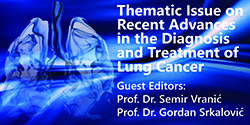Stethoscope vs. ultrasound probe - which is more reliable in children with suspected pneumonia?
DOI:
https://doi.org/10.5644/ama2006-124.155Keywords:
Pneumonia, Children, Ultrasound, AuscultationAbstract
Objective. To compare lung ultrasound (LUS) with auscultation findings in children with clinical suspicion of pneumonia. Patients and methods. A prospective study including 95 patients (age: from 2 months to 17.5 years; mean age: 5.1 y, SD 4.5 y) with referral diagnosis of suspected pneumonia. In all patients LUS and auscultatory examinations were performed within an hour. These findings were compared separately in each hemithorax. The radiologist performing LUS was blinded to the patient’s clinical information. Positive auscultatory findings included: crackles and/or abnormal breath sounds (decreased, asymmetric, absent, or bronchial). For LUS examinations a combined transthoracic – transabdominal approach was used. A pneumonia-positive LUS finding included subpleural consolidation with air-bronchogram, or an adjacent area of interstitial edema. For each subpleural consolidation the cranio-caudal (CC) diameter was measured, and 95% confidence intervals (CI) of the sizes of subpleural consolidations for positive and negative auscultatory findings were compared. The p-value between LUS and auscultation was calculated using McNemar’s test. Results. LUS and auscultation showed pneumonia-positive findings in 98 and 64 hemithoraces, i.e. in 67 and 45 patients respectively. In positive auscultatory findings the CI for CC diameters of subpleural consolidations ranged from 32.46 to 54.14 mm, and in negative auscultatory findings the CI was between 16.52 and 29.83 mm, which showed a statistically significant difference. McNemar’s test showed a statistically significant difference between LUS and auscultation. Conclusions. LUS showed positive findings in more hemithoraces than auscultation in children with suspected pneumonia. A cranio-caudal size of subpleural consolidation of less than 30 mm significantly reduces the possibility of auscultatory detection.






